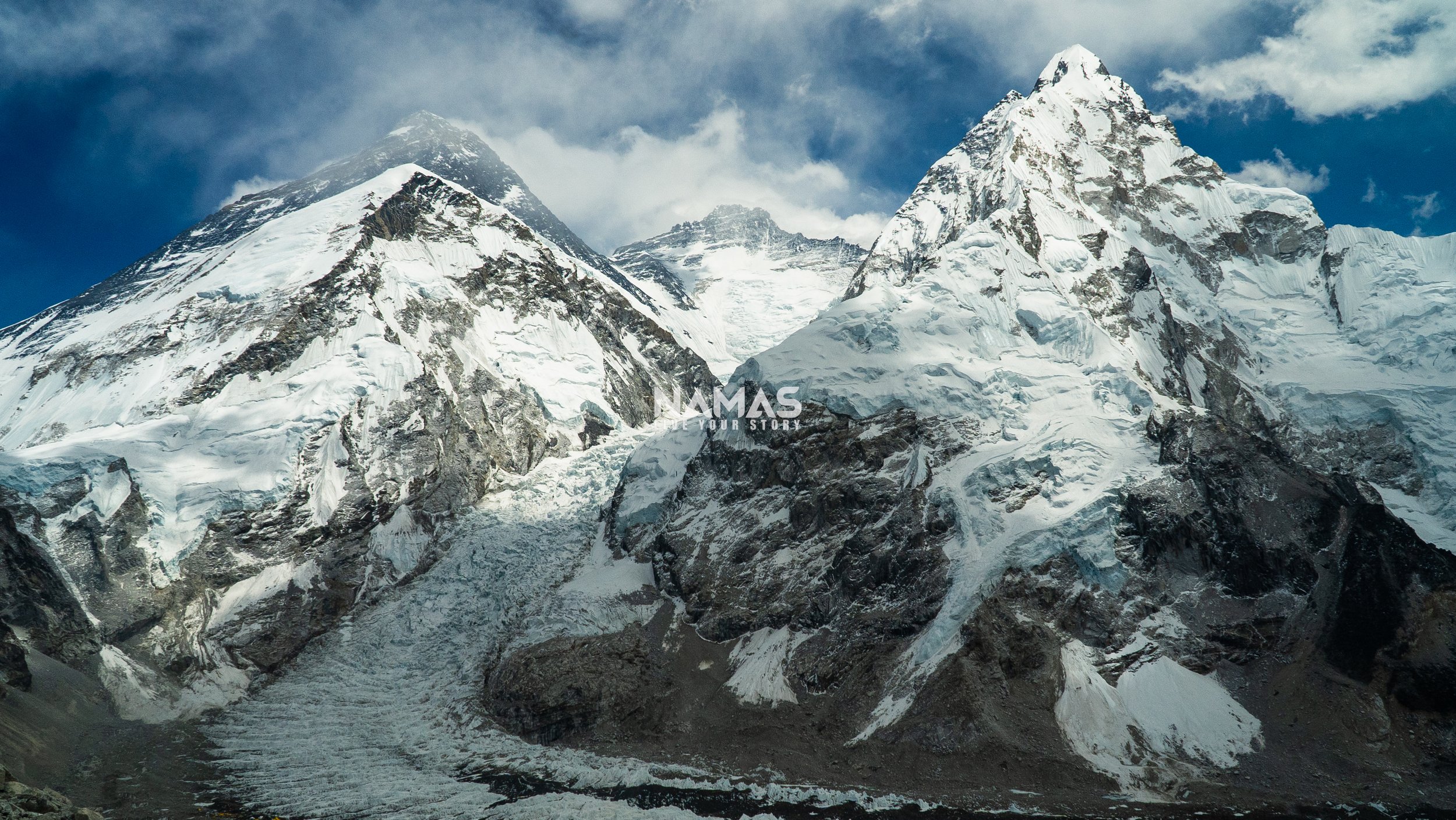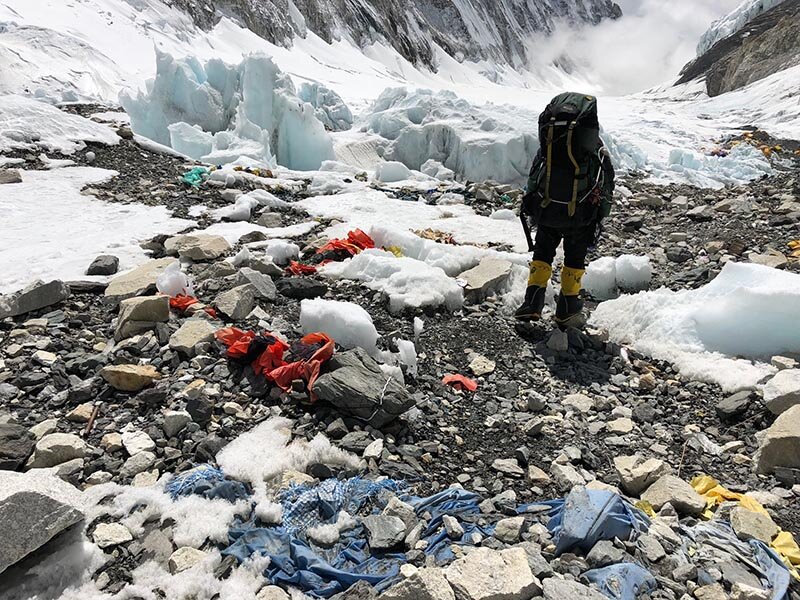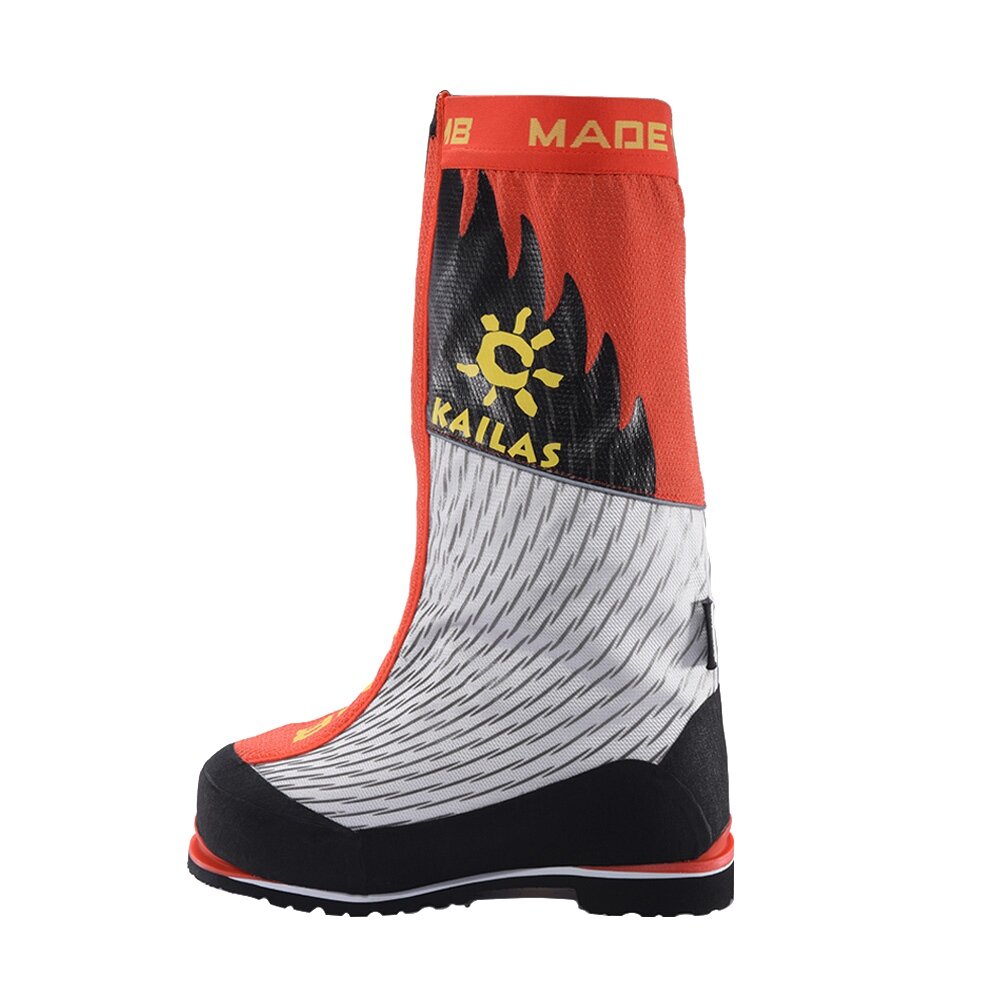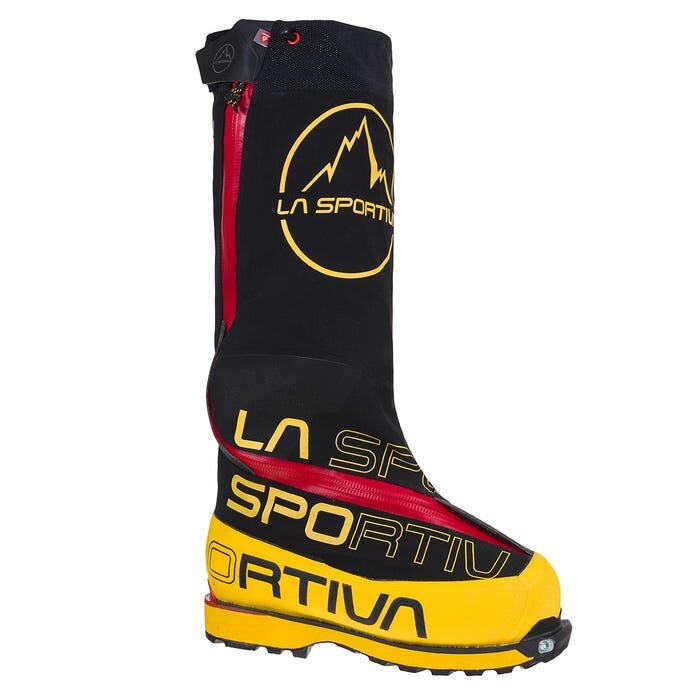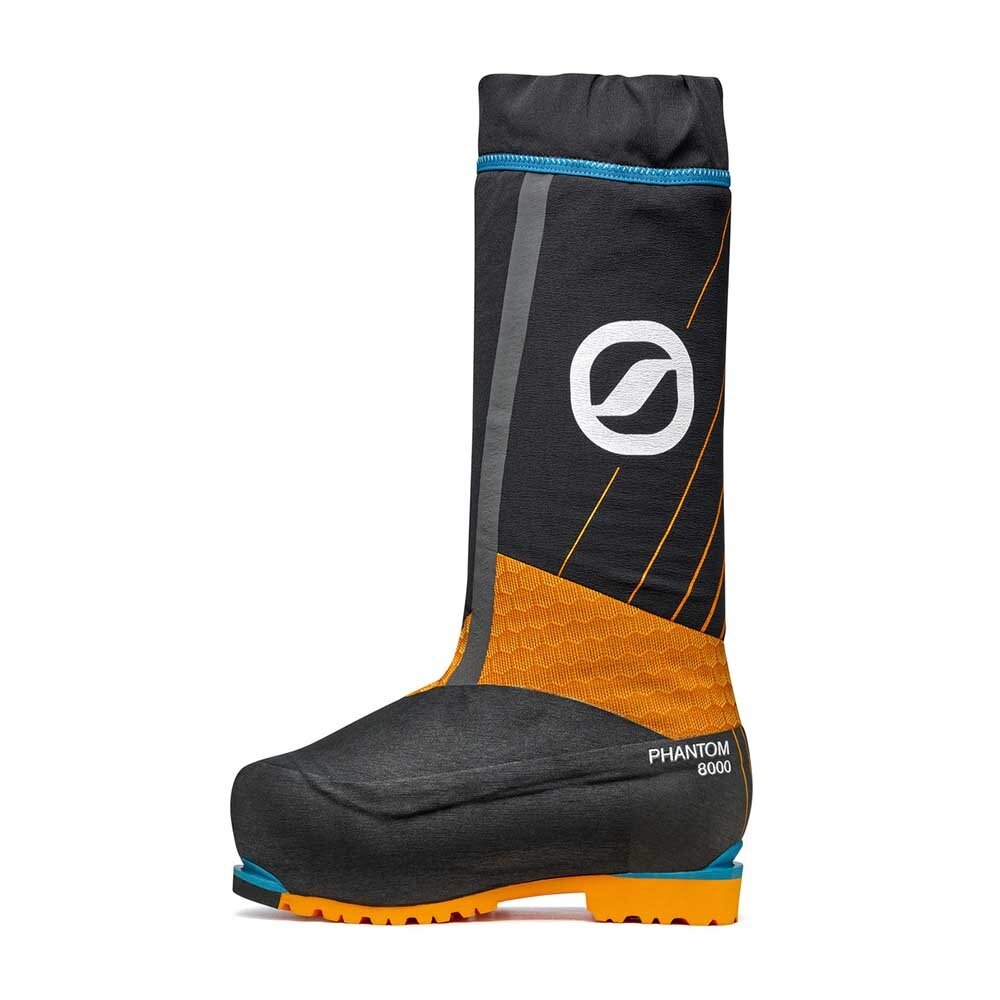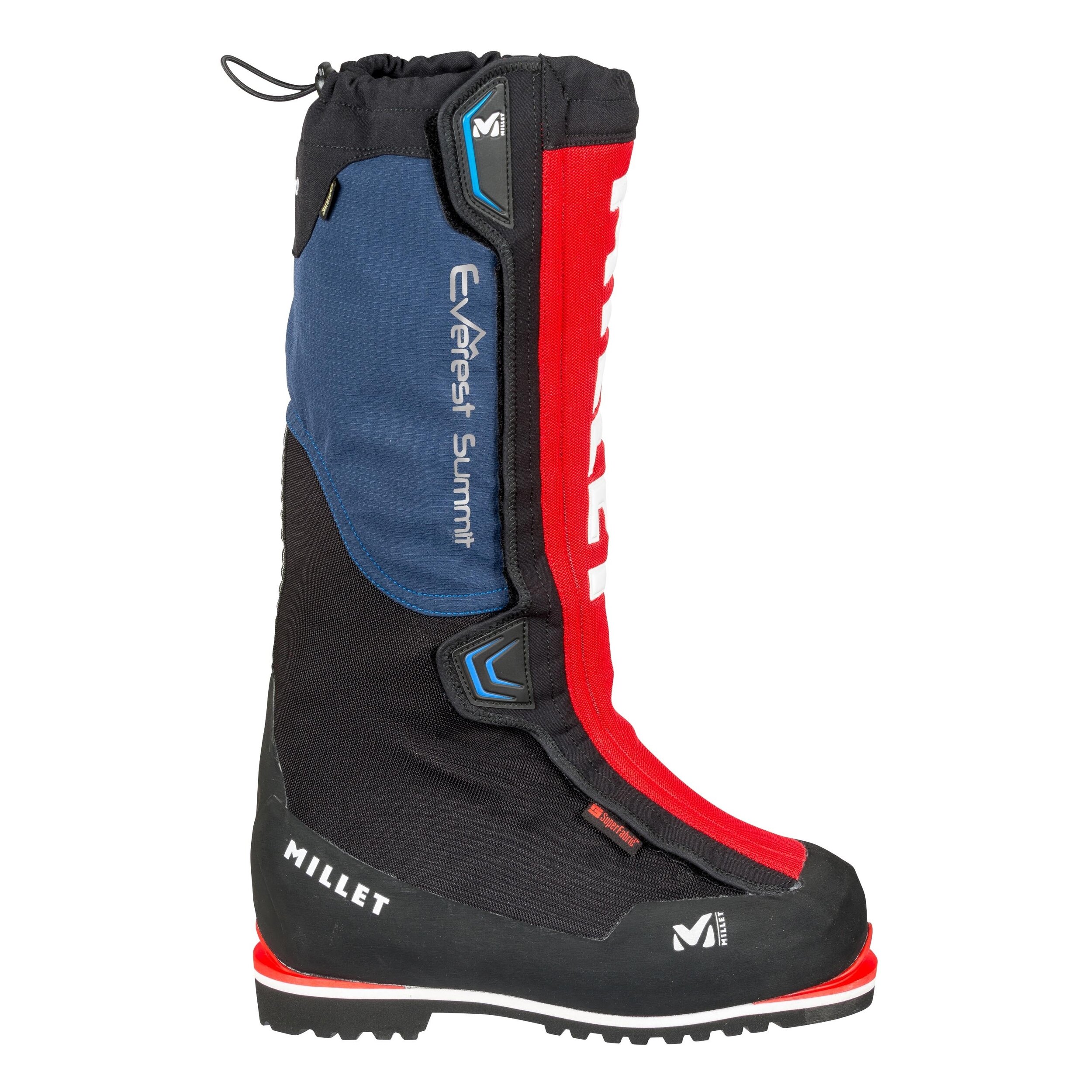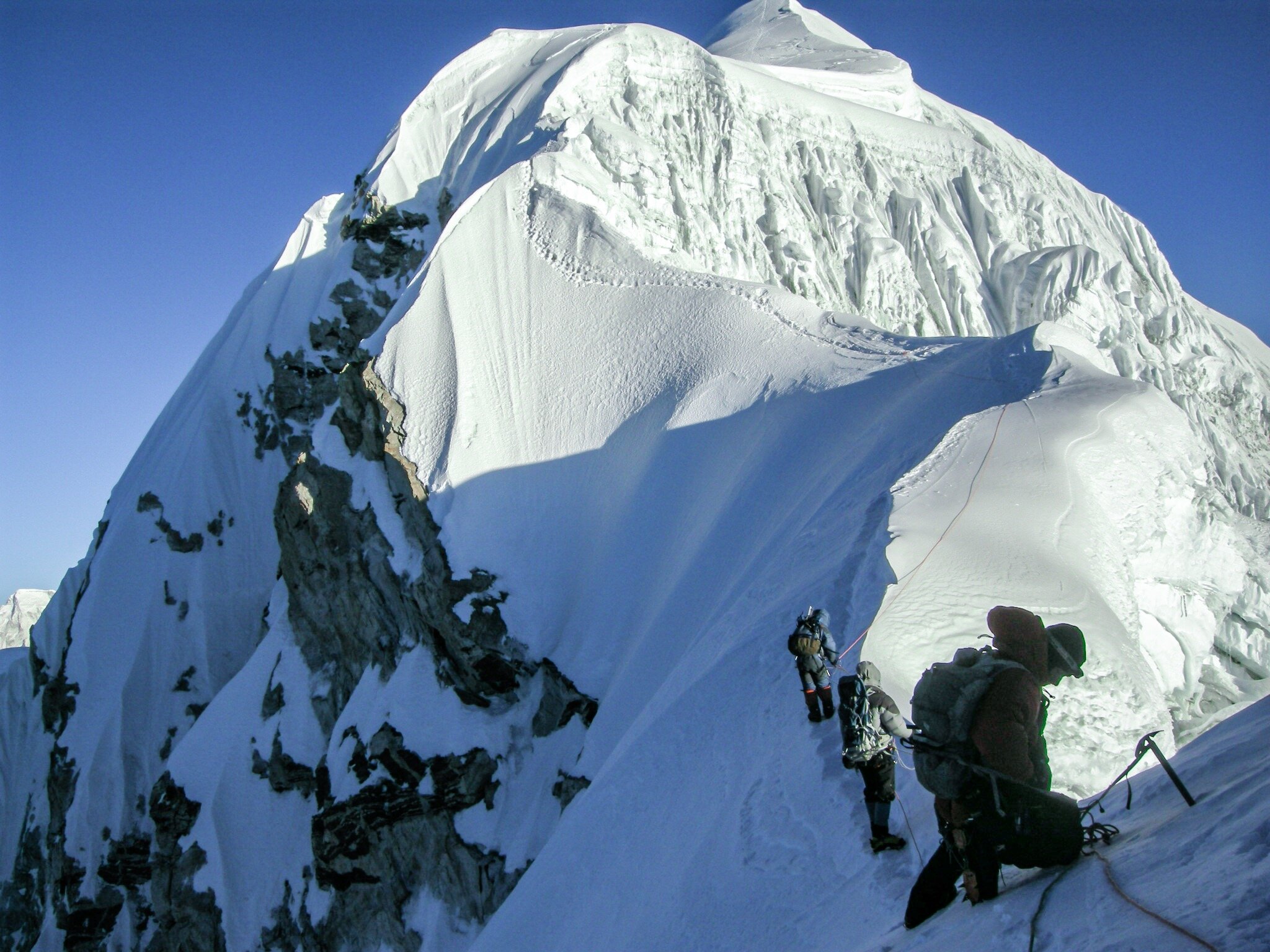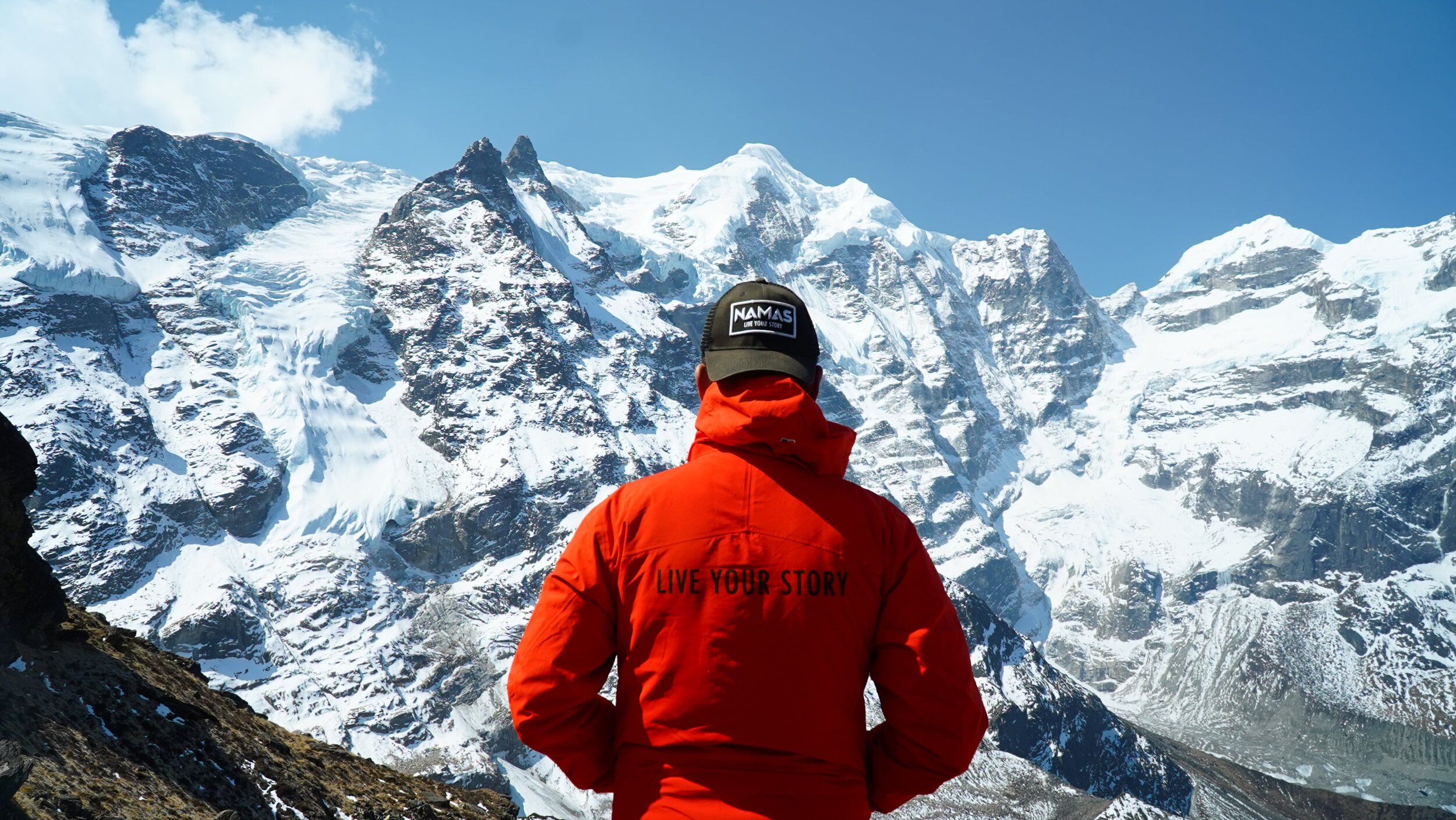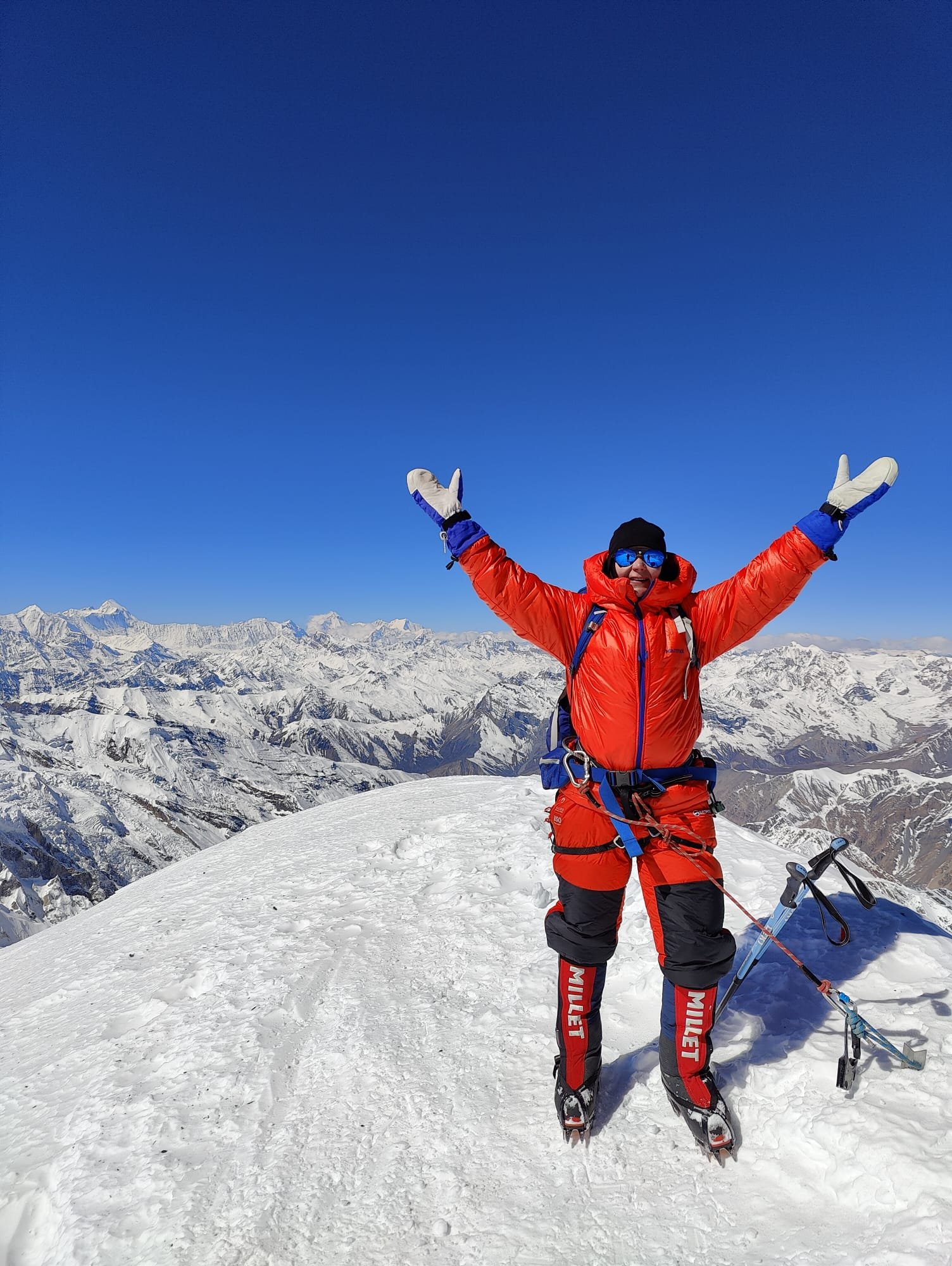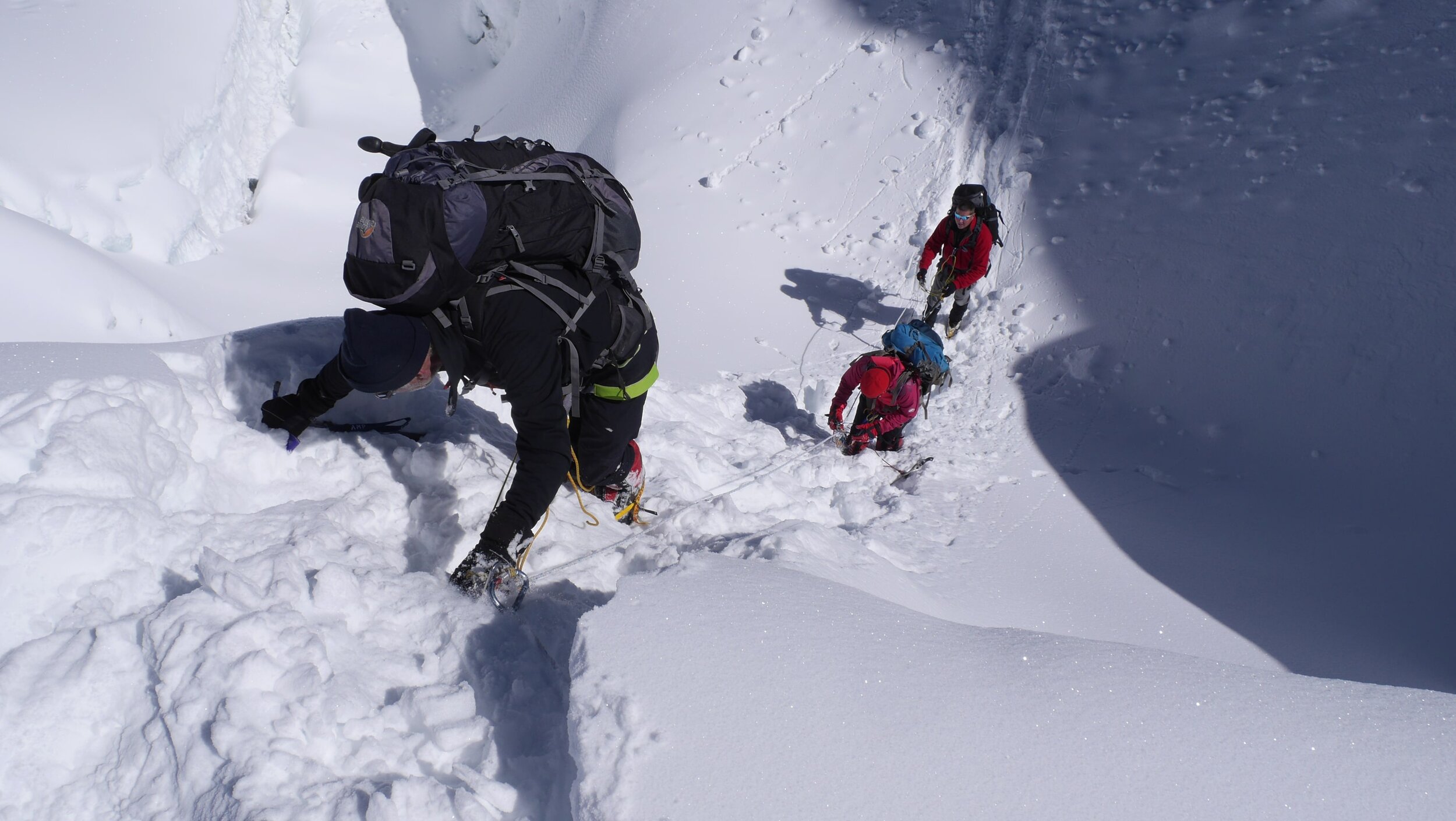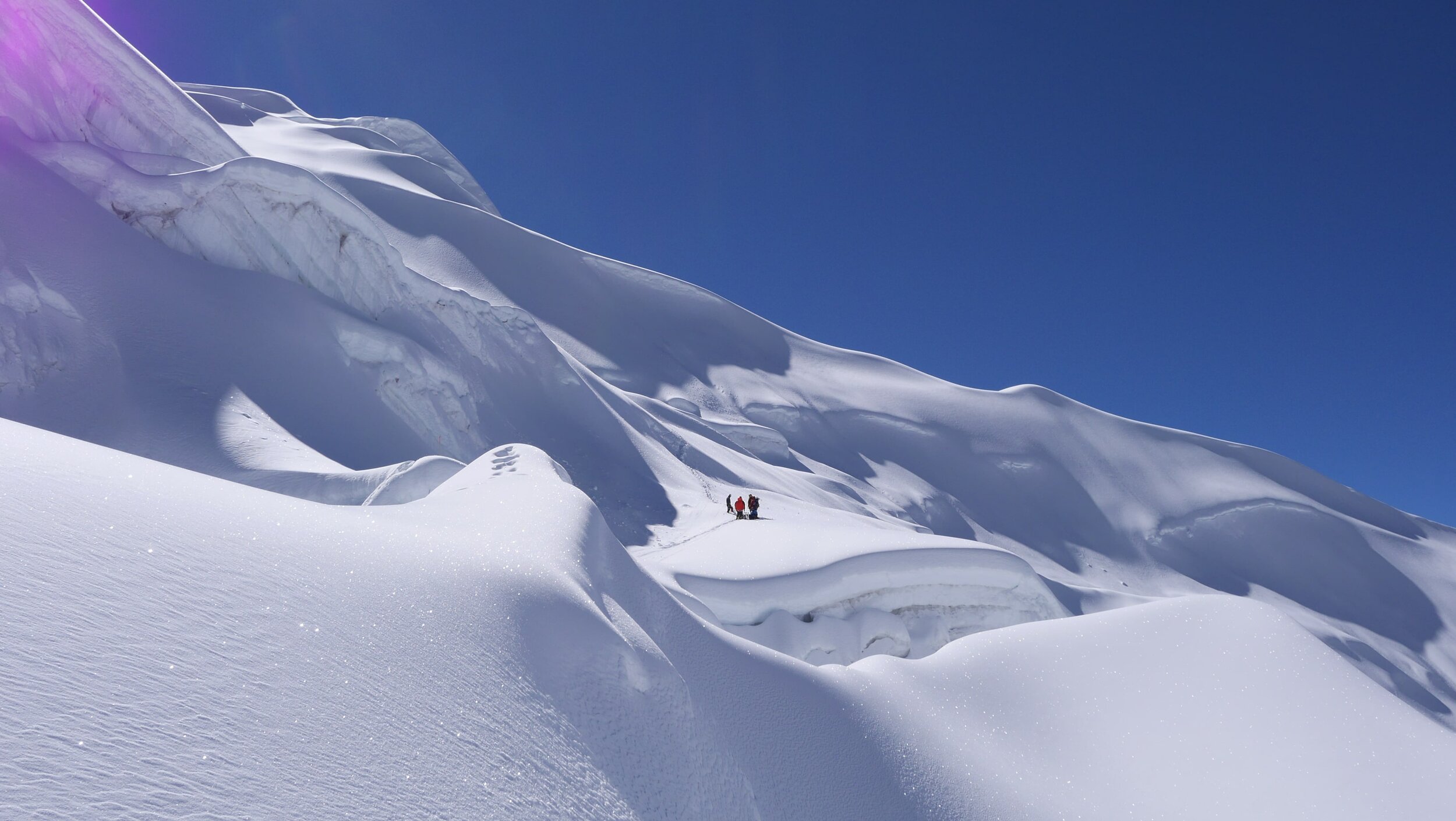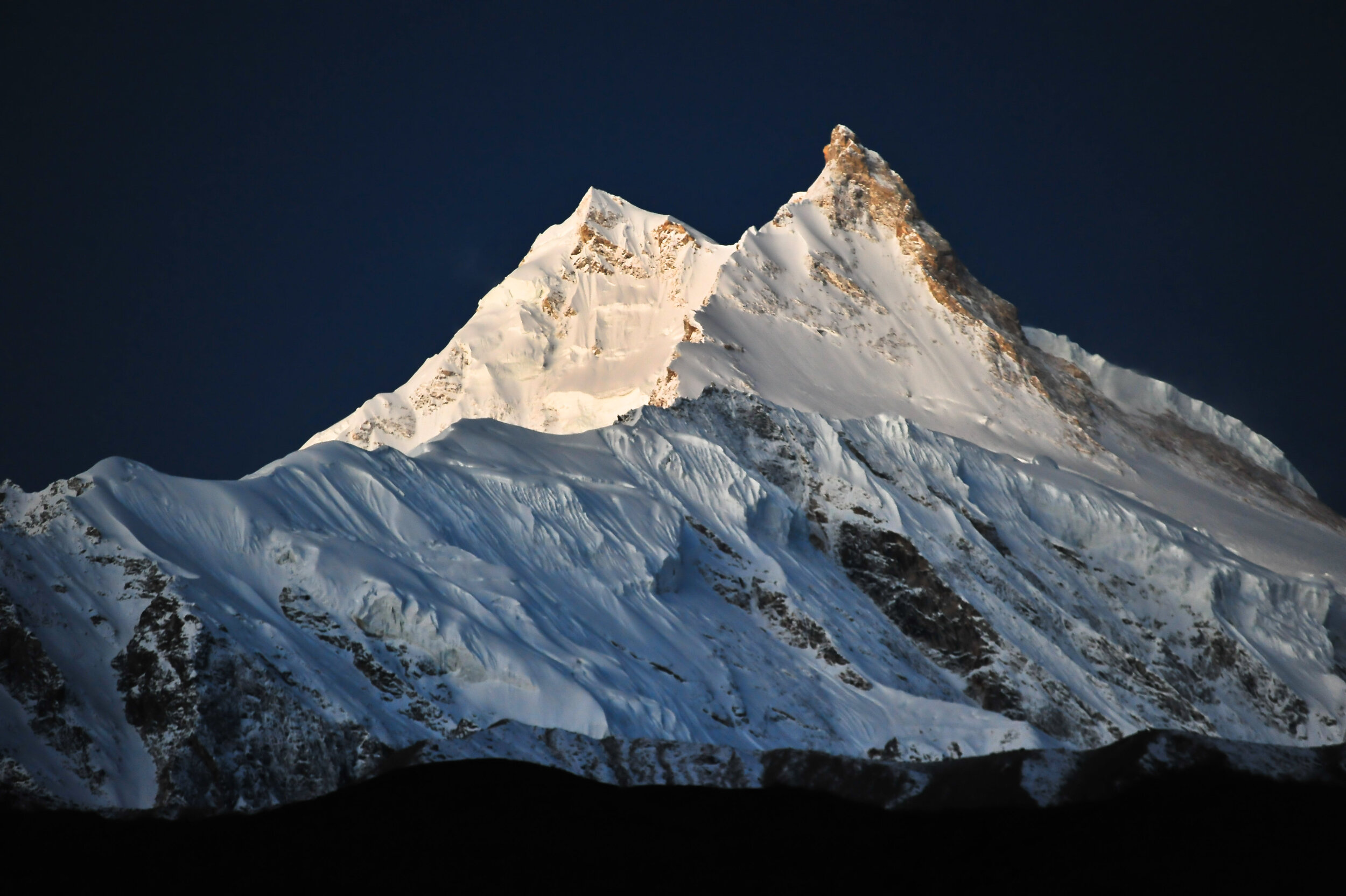Everything you need to know about MT. Everest 8848M Expedition
Note - Mt. Everest is officially a little higher. 8848.86M / 29,031.69FT (2020 new measurement)
1. When is the best time to climb Mt. Everest?
Spring (April-May) is the best time to climb Everest. All major commercial expeditions are organised during spring.
2. How much does Mt. Everest expedition cost? What does it include? How is Namas operating the expedition differently?
With our team, Namas Adventure team, your Everest expedition costs (website - click here). We provide premium high-quality all-inclusive peak climbing services. 🚁 Helicopter services to Lukla and rest day rotations BC - Namche Bazaar - BC and return to Lukla after your summit. Our team’s focus is your safety, successful summit, experiencing the local culture, and having fun. As a company, we are focused on our core values of being a responsible, ethical, and sustainable mountain adventure brand. Climbers do not have to worry about anything with our team and totally focus on their climbing holidays and fun times ahead.
List of what’s included in your booking.
IFMGA/NNMGA certified Guide leader
🚁 Shared helicotper Kathmandu to Lukla. BC to Kathmandu and to Kathmandu.
🚁 to Namche Bazzar for 3-4 days and fly back to BC
✈️ Kathmandu or Ramechap - Lukla - Kathmandu or Ramechap (for members without helicopter option)
$1000 Individual tip pool. (This is not a summit bonus tip) Tip pool will be fairly distributed among all Namas staff members. (Guides, porters, drivers, hotel security, and staff).Guest may personally hand in extra tips to our guides and porters)
Helicopter Charter From Kathmandu - Lukla. Base Camp - Namche Bazaar - BC. Base Camp - Lukla (Once the expedition ends)
Namas Branded merchandise (Down Jacket, Cap, Buff)
2:1 or 1:1 Guide/client ratio
1 Additional Sherpa Support for every 2 climbing members
Head chef and kitchen helpers (Helpers increase with the number of climbing team members)
2 nights before the expedition and 1 day after the expedition. Hotel in Kathmandu. Single room. (Should clients return early from their expedition, clients will be responsible for their extra Kathmandu hotel bookings)
All trekking and climbing permits (Khumbu Region Permit and TIMS)
All internal-local transportation to and from the trekking trailhead
Expedition tents, a single tent in Base Camps and shared in higher camps Brands Salewa, Mountain Hardwear, Samaya equipment, Kailas
8 or 16 Supplemental Oxygen Cylinders for client use
60 kgs personal weight
Meals for Camps 1 - 4
Burners and expedition equipment
Walkie-talkie/ Satellite phone
Breakfast, Lunch, and Dinner on trek and expedition days.
Lodge accommodation during the trek
Porters per guest
The arrival pick up and departure
Basic First aid kit
Welcome/Farewell leave Dinner
3. How is namas operating Mt. Everest expedition differently?
We will have a dedicated high-altitude porter(s) to transport our waste from Camps 1 and 2 to Base Camp. The client-leading Sherpa team will assist in bringing the waste down from Camps 3 and 4 to Camp 2 during rotations and the summit descent.
WAGBAG
All members are required to bring a wag bag for use at higher camps and to carry their wag bags down to Base Camp for proper disposal. While this might seem standard practice, not every company does this. We have been implementing this protocol since our first Everest expedition.
Once waste reaches Base Camp, it will be securely sealed and transported via yak down to the valley for proper disposal at a designated landfill site. We firmly believe that when conducting expedition operations in our mountains, we have a moral duty to protect the environment and keep it clean for future generations.
There is a growing concern about pollution and waste being left on the mountains. This is a legitimate concern that we share. In line with our commitment to sustainable values, we are implementing these waste management strategies and continuously improving our program to address this issue.
We appreciate your cooperation in maintaining the pristine condition of our beautiful mountains.
4. The first ascent and debate
Sir Edmund Hillary and Tenzing Norgay reached the summit on 29 May 1953 as part of the British expedition led by Lord John Hunt from the Nepal south col side. There is also the debate on whether George Mallory and Sandy Irvine reached the top of Everest from North side (tibet), on the final push of the 1924 expedition. They went missing soon after. No one knows whether they reached the top, a feat that, if proved, would rewrite climbing history.
5. The oldest and youngest person to climb Mt. Everest
The range of ages among those who have climbed Everest is staggering. The oldest person was Yuichiro Miura from Japan at 80 in 2013, while the youngest was American Jordan Romero at 13 in 2010.
A number of disabled climbers have reached the summit, including blind American Erik Weihenmayer in 2001 and double amputee Mark Inglis from New Zealand in 2006.
6. How many people have died on Everest?
Sadly 308 people have died on Everest, between 1922 and 2021. 165 have died on the Nepali side, while the remainder died on the Tibetan North side.
On 18 April 2014, 16 high-altitude local workers, including 13 Sherpas, were killed in the Khumbu Icefall below Camp 1, following a serac collapse on the mountain’s west shoulder. It was the worst single loss of life in the mountain’s history.
Despite this tragic loss of life, the fatality rate on Everest has been dropping in recent years, both for foreign climbers and hired high-altitude workers. According to the Himalayan Database – a useful resource for research on Everest – there were 61 deaths between 1950 and 1999 among high-altitude workers, a death rate of 1.52%. Between 2000 and 2014 there were 31 fatalities among high-altitude workers, a death rate of 0.57% – based on the number of journeys through the icefall.
7. Who holds the most Everest summit record?
Nepalese Sherpas hold the record for the most ascents. Kami Rita Sherpa X 29 summits and on second Ngima Nuru Sherpa X 22 summits.
8. How many climbing routes are there to climb Everest?
There are seventeen different routes to climb Everest. The two most famous and standard routes are South Col from Nepal and North Ridge from Tibet.
More detailed climbing routes on Alan Arnett's blog: https://www.alanarnette.com/blog/2017/12/28/comparing-the-routes-of-everest-2018-edition/
Image from Alan Arnett Blog site
9. What experience do climbers need to climb Mt. Everest? Are guides necessary to climb Mt. Everest?
If you are a total beginner then you will definitely want to check out our Road to Everest program.
Experiences - Previous high altitude climb of at least 1 X 7000M and 1 X 8000M+ of any alpine/mountaineering climbing experiences are absolutely necessary in order to climb Mt. Everest. It necessarily doesn’t have to be in Nepal but can be anywhere else in the world, although climbing in Nepal does help you get the wider understanding of climbing in Nepal. I.e.- local way of doing things, cultural perspective, bonding with local climbing leaders, their perspective on climbing big mountains etc. Climbers need to have good knowledge and experience of hiking/climbing using crampons on snow, ice, and steep surfaces. Be comfortable and proficient using a fixed rope to climb on steep and exposed sections. Climbers should be familiar with the use of climbing gears, basic rope techniques like tying safety knots and abseiling when coming down from the mountains and have the mental toughness to climb in cold and windy conditions.
For intermediate experience level climbers with no previous 7000M and 8000M climbing experience we highly suggest you build and gain the right experience before committing to climb Everest. Patience and right skill and experience is key and mostly the difference between death and survival in Everest.
Local Guides - By Nepalese law, when issuing permits for high altitude peaks above 6000M+ guides are a must. To issue a permit for Mt. Everest expedition process will have to go through a registered local company. However, if you are one of the experienced climbers with tons of climbing routes under your belt then there can be several routes that even local guides may not be able to climb. So even if you climbers want to explore new routes then taking a guide as a backup option would be a wise choice.
10. How many high camps are there on Mount Everest?
Strategically with Everest expedition we will have 4 high altitude camps.
Camp 1 (6,065M/19,900ft)
Camp 2 (6400M/20,997ft)
Camp 3 (7200M - 7500M/23,622+ft)
South Col or Camp 4 (7906M/25,938ft)
11. What is the best-acclimated itinerary for climbing Mt. Everest expedition?
Going slow and steady is the game when climbing extreme high altitude peaks. On extreme high altitude climbing expeditions it is imperative that climbers acclimatize properly so that the body is well-rested, adapted, and stronger to climb even higher. When we want to commit to climbing adventure at high altitude, slow and steady is the right way. Our itineraries have been refined and designed by our guides with years of climbing and guiding experiences.
On our Everest Expedition, our team will climb Lobuche East 6119M for their acclimatization/training peak and we will strategically conduct several rotations between Camp 1 - 3 to acclimatise properly.
During the main expedition, our base camp will be fully stationed and extra facilities will be available. We will conduct training day and several rotation to acclimatise during our expedition. More details are on our Everest climbing strategy.
Note - If you want to shorten your Everest (Express) itinerary to 45 days Namas team can make those arrangements.
12. What training is required/experience for Mt. Everest expedition climb? Can you suggest to me a training plan?
Everest is the ultimate climb for many and by no means is an easy climb and we require interested climbers to have a previous high altitude of at least 1X 7000M and 1X 8000M+ climbing anywhere in the world. Mountains are graded based on their technical and physical difficulties. To keep it short you will have to be at your absolute best physical fitness shape. For your training, it is very hard to mimic walking on ladders like the ones you will come across when crossing the crevasse in the ice fall or even the high altitudes.
We highly recommend focusing on endurance, core, and strength training. Any type of aerobic exercise, like long-distance running (20km+) 3 to 4 times a week, cycling (1 hour - 2 hours), hiking gaining elevation with 15-20kgs weights on are some of the suggested training. Another aspect you will want to focus is on strength building and muscle endurance training. Kettlebell routines are one of the best workout we can recommend. We advise you to schedule your training at least 6 - 12 months before your climbing departure. More on our training mountain expedition blog.
13. How hard is Mt. Everest climbing expedition?
Everest expedition is graded at E / 5 in difficulty. (Alpine/Fitness grading link).
We cannot stress enough but it’s very important climbers are mountain fit and strong before starting the expedition. In total, we will have 45 days of alpine climbing days and the climb will demand every ounce of your will, fitness, and awareness.
When we depart from Everest base camp our first objective challenge of navigating the great Khumbu icefall begins, mostly climbing on steep ice, jumaring, climbing on ladders just between the crevasse and ascending up the huge icefall to camp 1. As we go into higher elevation breathing will be challenging but with proper rotation acclimatization done ahead of time and by staying well hydrated and consuming enough nutrition, you should be able to cope with the altitude.
Summit day climb starts early with the goal to reach the summit or near to the summit before sunrise. This will be another challenging day mixed with a day of accomplishment. You can expect to climb around 16+ hours as you will have to summit and then descend back to camp 3 or camp 2 and then descend towards base camp the next day. Our teams will already have set up Everest base camp and the remaining 4 camps before client members reach there on their rotation and climbing days. Training walking on ladders, ice climbing and rotations are all meant to prepare you and acclimatize you for your summit. All your previous training of endurance and strength training should have prepared your body and mind to face these challenges.
What are the clothing and gears - boots required for Mt. Everest expedition climb (trekking and mountaineering)? Can I rent gears for Mt. Everest expedition climb?
Choosing the right gear is very important. We advise climbers not to make compromises on the quality of gears and clothing, and to pay attention to layer up comfortably as well. You will depend highly on your clothes to keep you warm enough for the dropping temperatures at nighttime which can go down to -20c /-40c. Please check our equipment blog for recommended clothing and gear.
Renting your gears in Nepal? The simple answer is NO. This is one of the most frequently asked questions mainly by beginner climbers. We have tested and tried several gears in Nepal and frankly, we do not recommend hiring here. We know it might seem like a huge amount of expenses to buy all the gears, but they are well worth it. You can even hire from the city you live in. Make sure they are the original products from well-known adventure gear companies. (North face, Mountain hardware, Kailas, etc.)
Boots for Everest Expedition
With better technologies, climbing shoes have improved every year. We highly recommend double-layered boots like Kailas Everest 8000M, La Sportiva Olympus Mons Cube, Scarpa 8000 phantom, Millet Everest summit GTX. It is wise to spend on good mountaineering boots, as so with all the gears that we have mentioned in this post above.
More 8000M boots link here (other media article)
14. What types of foods are available during Mt. Everest Expedition? Is clean water available and how much water intake is recommended? Hydration and nutrition
On your hike to the base camp, most of the foods are prepared in the tea houses. Once we reach base camp we will have our own base camp station. Our Everest base camp kitchen will be the best, where our amazing chef will prepare foods that will surprise you with what you can find at that altitude. Throughout your climbing period foods are prepared by our base camp kitchen staff members.
In the high altitudes, as the weather is extremely cold, your body will naturally want to reject food or avoid using energy on anything, which includes eating too. You might have to force yourself with the first few couple of bites and then eventually your body will start accepting the food. We also provide packed dried meals, so that clients have other options should they not want to eat what’s being cooked and served to them. We suggest all our clients to drink 4-6 l of water every day. Staying hydrated will also help you with acclimatizing properly. It’s best to take hydration tablets or filtration bottles with you.
Remember to avoid smoking and any alcohol intake. You might see our guiding leaders smoking or drinking but remember they are professionals and they have adapted very well to these environments compared to the climbers who go there just for adventure holidays.
15. What trip insurance will I need for Mt. Everest Expedition? Do I need helicopter evacuation to be included in my insurance cover?
No matter how prepared you are, you never know when or how things might go wrong. You might be sick suddenly or not that we wish but there might be some incident, you might suffer from altitude sickness or anything we can’t imagine yet. So, for these reasons, it is always good to have insurance cover. Our recommended Insurance companies (link)
We highly recommend Global Rescue as your insurance provider. Helicopter evacuation is our final emergency option and we do recommend you have one in your insurance, as it is the only means of transport in the Everest region. Our guides will assess your condition and examine if it is a major issue. If not, they will use their experience to motivate and push you through your trip. However, in case of emergency, helicopter evacuation will be called upon.
There is a procedure to follow when calling for emergency evacuation. We will call the insurance company hotline, get approval with your insurance reference number, and only then helicopters are sent to the distress call location. You will have to pay for the evacuation in Nepal from your own pocket but once you are back home you can claim your money back. Make sure you collect helicopter evacuation receipts, certified doctor’s approval letter. The insurance company will ask for this evidence to back up your claim. There was a huge helicopter scam in Nepal during 2018, so insurance companies are taking extra measures to stop this from happening. Our guides and staff members in Kathmandu will also remind you of this process during briefings.
16. Next climbing goals after Mt. Everest Expedition climbing
Everest expedition being one of the most sought out expedition is also one of the expedition with the most organised facilitated expedition. After completing your Everest expedition successfully there are are other mind boggling and challenging/adventure filled expedition which we can recommend.
1. Annapurna 1, 8091m
The iconic Annapurna 1, is known for being one of the difficult and dangerous 8000er to climb.
2. K2, 8611M
K2, another dangeours and difficult second highest peak in the world.
If you do have any more questions, please ask us below in the comment section or you can email us at bookings@namasadventure.com and our team will get back to you as soon as they can. Stay well. Challenge yourself. Dare great things and live your story.
Other related articles:
Everything you need to know about Tilicho Peak 7134M Expedition - Namas Adventure
Tilicho base camp is set on the east side of the Mountain at 4900M
1. When is the best time to climb Tilicho peak?
Autumn (September - Mid November) is the best time to organise Tilcho Peak 7134M expedition.
2. How much does Tilicho 7134M Expedition cost? What does it include? How is Namas operating the expedition differently?
With Namas Adventure/Expedition team, please check our website (link). We provide premium high-quality all-inclusive peak climbing services. Our team’s focus is your safety, successful summit, experiencing the local culture having fun. As a company, we are focused on our core values of being a responsible, ethical, and sustainable mountain adventure brand. Climbers do not have to worry about anything with our team and totally focus on their climbing holiday and fun times ahead. We explore the least climbed and remote peaks in the Himalayas and around the globe.
List of what’s included in your booking.
IFMGA/NNMGA certified Guide leader
$500 Individual tip pool. Tip pool will be fairly distributed among all Namas staff members. (Guides, porters, drivers, hotel security, and staff). Guest may personally hand in extra tips to our guides and porters)
Namas Branded merchandise (800 or 900 Fill Down Jacket, Cap, Buff)
1:1 Sherpa/client ratio. (Additional 1:1 Sherpa can be arranged, extra charges apply)
Head chef and kitchen helpers (Helpers increase with the numbers in climbing team members)
Arrival hotel in Kathmandu
All trekking and climbing permits (ACAP region Permit and TIMS)
All internal-local transportation to and from the trekking trailhead
Expedition tents (2 or 1 person tents) Brands Salewa, Mountain Hardwear, Samaya equipment, Kailas
40 kgs personal weight
Freezed dried meals during camping days (Chicken, mushroom, vegan options etc)
Chocolate, energy bars, hydration pills, biscuits, canned foods, nuts
Burners and expedition equipment
Walkie talkie/ Satellite phone
Breakfast, Lunch, and Dinner on trek and expedition days.
Lodge accommodation during the trek
Porters per guest
Arrival pick up and departure
Internal flights
Basic First aid kit
Welcome/Farewell leave Dinner
3. The first ascent of Tilicho peak 7134M.
Tilicho Peak was first climbed by a French expedition led by Emanuel Schmutz in 1978 via the North West Shoulder.
4. How many climbing routes are there to climb Tilicho Peak?
Officially Tilicho peak has only been summited via the northwest shoulder.
5. What experience do climbers need to climb Tilicho Peak expedition? Are guides necessary?
Experiences - Previous high altitude climb of at least 1 X 6000M and several technical peaks of with alpine/mountaineering climbing experiences are absolutely necessary in order to climb Tilicho peak mountain. It necessarily doesn’t have to be in Nepal but can be anywhere else in the world, although climbing in Nepal does help you get a wider understanding of climbing in Nepal. I.e.- local way of doing things, cultural perspective, bonding with local climbing leaders, their perspective on climbing big mountains etc.
Climbers need to have good knowledge and experience of hiking/climbing using crampons on snow, ice, and steep surfaces. Be comfortable and proficient using a fixed rope to climb on steep and exposed sections, traversing on mountain slopes and climbing through spurs on the routes. Climbers must be highly efficient with the use of climbing gears, basic rope techniques like tying safety knots, and abseiling when coming down from the mountains, and have the mental toughness to climb in cold and windy conditions.
This expedition is not for intermediate experience level climbers.
Local Guides - By Nepalese law, when issuing permits for high altitude peaks above 6000M+ guides are a must. To issue a permit for Mt. Everest expedition process will have to go through a registered local company. However, if you are one of the experienced climbers with tons of climbing routes under your belt then there can be several routes that even local guides may not be able to climb. So even if you climbers want to explore new routes then taking a guide as a backup option would be a wise choice.
6. How many high camps are there on this expedition?
Strategically on Tilicho peak expedition, we will have 2 to 3 high-altitude camps.
Camp 1 (5800M)
Camp 2 (6200M)
Camp 3 (6600M) - possibility after assessing the weather, snow/ice and other objective dangers in the mountains.
7. What is the best-acclimated itinerary for climbing Tilicho peak expedition?
Going slow and steady is the game when climbing extreme high-altitude peaks. On extreme high altitude climbing expeditions, it is imperative that climbers acclimatize properly so that the body is well-rested, adapted, and stronger to climb even higher. When we want to commit to climbing adventure at a high altitude, slow and steady is the right way. Our itineraries have been refined and designed by our guides with years of climbing and guiding experiences.
During the expedition, our team will do a couple of rotations between camps 1 and 2 to acclimatize and get familiar with the routes. This gives our body to acclimatize at the extreme altitude and drop supplies at higher camps.
Note - If you want to shorten your Tilicho Peak (Express) itinerary to 24-25 days Namas team can make those arrangements.
8. What training is required/experience for Tilicho Peak expedition climb? Can you suggest to me a training plan?
Tilicho peak is graded at D+ (Fitness level) and by no means should this expedition be taken lightly and we require interested climbers to have a previous high altitude of at least 1X 7000M or 8000M+ climbing anywhere in the world. Mountains are graded based on their technical and physical difficulties. To keep it short you will have to be at your absolute best physical fitness shape. For your training, past climbing experiences, knowledge all play a vital role in order to successfully complete this expedition.
We highly recommend focusing on endurance, core, and strength training. Any type of aerobic exercise, like long-distance running (20km+) 3 to 4 times a week, cycling (1 hour - 2 hours), hiking gaining elevation with 15-20kgs weights on are some of the suggested training. Another aspect you will want to focus is on strength building and muscle endurance training. Kettlebell routines are one of the best workout we can recommend. And nothing beats the good old ways of climbing other smaller peaks and testing yourself before your main expedition. We advise you to schedule your training at least 6 - 12 months before your climbing departure. More on our training mountain expedition blog.
9. How hard is Tilicho Peak climbing expedition?
Tilicho Peak expedition is graded at D+/ 4 in difficulty. (Alpine/Fitness grading link).
We cannot stress enough but it’s very important climbers are mountain fit and strong before starting the expedition. In total, we will have 14 days of alpine climbing days and the climb will demand every ounce of your will, fitness, and awareness.
When we depart from Tilicho base camp 4900M our first objective challenge is to reach camp 1 navigating the ridge of North shoulder climbing through. spurs and steep 70 to 90 degree climbs to reach camps 1 and 2. Mostly climbing on steep ice, jumaring, and traversing on exposed ridges.
Summit day climb starts early with the goal to reach the summit or near to the summit before sunrise. and the wind starts to pick up. This will be another challenging day mixed with a day of accomplishment as we climb to gain 500+M to reach the summit and descend down back to camp 1. You can expect to climb for around 16+ hours as you will have to summit and then descend as any normal climbs. Our base camp team members meanwhile will be waiting for your arrival. All your previous training of endurance and strength training should have prepared your body and mind to face these challenges.
10. What are the clothing and gears - boots required for Tilicho Peak climb (trekking and mountaineering)? Can I rent gears for this expedition climb?
Choosing the right gear is very important. We advise climbers not to make compromises on the quality of gears and clothing, and to pay attention to layer up comfortably as well. You will depend highly on your clothes to keep you warm enough for the dropping temperatures at nighttime which can go down to -20c /-40c. Please check our equipment blog for recommended clothing and gear.
Renting your gears in Nepal? The simple answer is NO. This is one of the most frequently asked questions mainly by beginner climbers. We have tested and tried several gears in Nepal and frankly, we do not recommend hiring here. We know it might seem like a huge amount of expenses to buy all the gears, but they are well worth it. You can even hire from the city you live in. Make sure they are the original products from well-known adventure gear companies. (North face, Mountain hardware, Kailas, etc.)
Boots for Mount Tilicho peak 7134M Expedition
With better technologies, climbing shoes have improved every year. We highly recommend double-layered boots like Kailas Everest 8000M, La Sportiva Olympus Mons Cube, Scarpa 8000 phantom, Millet Everest summit GTX. It is wise to spend on good mountaineering boots, as so with all the gears that we have mentioned in this post above.
More 8000M boots link here (other media article)
11. What types of foods are available during Tilicho Peak Expedition? Is clean water available and how much water intake is recommended? Hydration and nutrition
On your hike to the base camp, most of the foods are prepared in the tea houses. Once we reach base camp we will have our own base camp station. Our tilicho base camp kitchen will be the best, where our amazing chef will prepare foods that will surprise you with what you can find at that altitude. Throughout your climbing period foods are prepared by our base camp kitchen staff members.
In the high altitudes, as the weather is extremely cold, your body will naturally want to reject food or avoid using energy on anything, which includes eating too. You might have to force yourself with the first few couple of bites and then eventually your body will start accepting the food. We also provide packed dried meals, so that clients have other options should they not want to eat what’s being cooked and served to them. We suggest all our clients to drink 4-6 l of water every day. Staying hydrated will also help you with acclimatizing properly. It’s best to take hydration tablets or filtration bottles with you.
Remember to avoid smoking and any alcohol intake. You might see our guiding leaders smoking or drinking but remember they are professionals and they have adapted very well to these environments compared to the climbers who go there just for adventure holidays.
12. What trip insurance will I need for this Expedition? Do I need helicopter evacuation to be included in my insurance cover?
No matter how prepared you are, you never know when or how things might go wrong. You might be sick suddenly or not that we wish but there might be some incident, you might suffer from altitude sickness or anything we can’t imagine yet. So, for these reasons, it is always good to have insurance cover. Our recommended Insurance companies (link)
We highly recommend Global Rescue as your insurance provider. Helicopter evacuation is our final emergency option and we do recommend you have one in your insurance, as it is the only means of transport in the Everest region. Our guides will assess your condition and examine if it is a major issue. If not, they will use their experience to motivate and push you through your trip. However, in case of emergency, helicopter evacuation will be called upon.
There is a procedure to follow when calling for emergency evacuation. We will call the insurance company hotline, get approval with your insurance reference number, and only then helicopters are sent to the distress call location. You will have to pay for the evacuation in Nepal from your own pocket but once you are back home you can claim your money back. Make sure you collect helicopter evacuation receipts, certified doctor’s approval letter. The insurance company will ask for this evidence to back up your claim. There was a huge helicopter scam in Nepal during 2018, so insurance companies are taking extra measures to stop this from happening. Our guides and staff members in Kathmandu will also remind you of this process during briefings.
13. Next climbing goals after Tilicho Peak Expedition climbing
Once you complete your objective of climbing Tilicho Peak you can start to plan further into other technical high altitude peaks that satisfy your climbing objective.
1. Ama Dablam 6819M and Island Peak 6189M climbing expedition
Technically difficult and climbing goal for many mountaineers. Ama Dablam is well renowned as one of the most beautiful and exposed Himalayan mountain in the Everest region. It is one of the most sought mountains to climb by mountaineering enthusiasts. Plan to do it before or after your bigger expedition like Everest as Ama Dablam climb in itself is a mountaineering challenge on its own. Ama Dablam is considered "a must-do" for alpinist and mountaineers.
2. Mera, Baruntse and Makalu (Triple Combo) or Baruntse with Mera Peak
Makalu Triple combo climbing expedition is one of the exciting mountain climbing expedition we organise at Namas Adventure. Climb the 5th highest peak in the world which is technically challenging but with a mix of climbing Mera Peak 6476M as your acclimatisation peak and Baruntse 7129M as your training peak. Mera Peak will be the most comfortable climbing peak helping you acclimatise and then we proceed onto the next 7000M peak objective of climbing Baruntse. The idea is to summit a 6000M+ peaks then to 7000M+ peak and then finally a 8000M peak.
Baruntse peak 7129M is one of the most remote peak sitting between Makalu and Everest/Lhotse. We will use this expedition to acclimatise further and also to train/refresh our climbing skills at higher altitude. Climbing Baruntse peak should further prepare us for taking on our final objective of climbing Makalu. After summiting Baruntse we then proceed towards Makalu base camp descending down via Sherpani col route.
Makalu 8463M will be the ultimate goal for this expedition. A mix of technical climb and extreme altitude this climb does not come easy. This expedition challenge is perfect after Everest expedition. You will need a serious endurance and strength in your fitness tank. Make this part of your climbing how ever it suits you. Some climbers want to climb all 14 X 8000M peaks or just another 8000M peak climbing achievement. What ever your goal Makalu is one of the best expedition to take on before or after Everest expedition.
We hope the information we have provided above will help you decide/prepare in the best way before you embark on your ultiamate dream of climbing Mt. Everest. If you are looking for a great climbing team and want to have an amazing time in Nepal then we would love to have you onboard for our Mt. Everest Expedition. You can be assured that you are provided quality services with our fun-loving yet professional guides who have 5 - 10+ years of taking clients on Everest summit successfully. After all we do aim to be the best adventure specialist in the world and you having a great time, being safe and summiting will always be our priority.
3. Manaslu 8163M Expedition
Want to experience 8000M+ a death zone altitude and gain the right experience for Everest or other higher extreme altitude climb? Manaslu Expedition is for any aspiring mountaineers who are considering climbing an 8,000m peak or higher. Manaslu has to be one of the preferred options if you are looking to climb the 8000M peaks and is also a necessary option to get that 8000M experience before attempting to climb Mount Everest. The expedition begins with trek to Manaslu trails passing through the village at the foot of the mountain where then arrive at Manaslu Base Camp to begin the climb.
4. Mt. Everest 8848M Expedition, Nepal
Your ultiamte expedition climbing to the Roof of the world. Mt. Everest Expedition.
If you do have any more questions, please ask us below in the comment section or you can email us at bookings@namasadventure.com and our team will get back to you as soon as they can. Stay well. Challenge yourself. Dare great things and live your story.
Other related articles:
Everything you need to know about Himlung Himal 7126M climbing Expedition - Namas Adventure
Himlung Himal, standing at 7126 meters, is a popular and relatively safe choice for climbers looking to tackle a 7000-meter peak in Nepal. Located in the rain shadow region of mid-western Nepal, this mountain offers a semi-technical climbing route with fixed ropes available to help you reach the summit. The climbing route is mostly on ice and snow, with a steep, exposed ascent to the top. Sherpa guides from different groups often work together to set up the ropes on climbing days. If you're seeking a high-altitude climbing adventure or are looking to progress to 8000M peaks or difficult challenging peaks, Himlung Himal is a must-climb.
Overview:
Altitude: 7126M / 23,379ft
Climbers experience level: Intermediate/Advanced
Location: Annapurna Region
When to climb?: Late spring Mid April - May and September - October
Total no of days: 30 Days
Difficulty grading: AD+/4 (Alpine/Fitness grading info)
Accommodation: Lodges and Base camp, Camp 1/2/ 3(Optional)
We have listed 10 useful pieces of information that will help you prepare for your Himlung Himal peak climbing expedition.
1. When is the best time to climb Himlung Himal?
Himlung Himal is best suited to climb during the mid-spring season around mid-April to May or during the early autumn season; just towards the end of the monsoon season. End of August to the end of October.
Note - Himlung is one of the remote climbing peaks with very few teams attempting the climb every year. You can be certain there won’t be many climbers or traffic during your expedition.
2. How much does the Himlung Himal expedition cost? What does it include?
Join the Namas Adventure team for a Himlung Himal expedition at a cost of $9050 per person. Our all-inclusive peak climbing services are of the highest quality and prioritize your safety with a 1:1 guide-client ratio, several successful summits, 100% safety records, and cultural immersion. As a responsible, ethical, and sustainable mountain adventure brand, we are committed to our core values and ensuring that you can fully enjoy your climbing holiday without worrying about any logistics. With our team by your side, you can focus on the fun and adventure ahead.
List of what’s included in your booking.
IFMGA/NMA certified Guide leader
$500 Individual tip pool. Tip pool will be fairly distributed among all Namas staff members. (Guides, porters, drivers, hotel security, and staff). Guest may personally hand in extra tips to our guides and porters)
Namas Branded merchandise (Down Jacket, Cap, Buff)
1:1 Sherpa Guide /client ratio
Head chef and 2 kitchen helpers (Assistants increase with the number of climbing team members )
Arrival hotel in Kathmandu
All trekking and climbing permits (Annapurna Region Permit and TIMS)
All internal-local transportation to and from the trekking trailhead
Expedition tents (2 or 1-person tents ) Brands Salewa, Mountain Hardwear, Samaya equipment, Kailas
40 kgs personal weight
Freezed dried or meals during camping days (Chicken, mushroom, vegan options, etc)
Chocolate, biscuits, canned foods, nuts
Burners and expedition equipment
Walkie-talkie/ Satellite phone
Breakfast, Lunch, and Dinner on trek and expedition days.
Lodge accommodation during the trek
Porters per guest
Arrival pick up and departure
Internal flights
Basic First aid kit
Welcome/Farewell leave Dinner
3. What experience do climbers need to climb Himlung Himal? Are guides necessary for Himlung Himal climb?
Experiences - It is essential for climbers to have previous high-altitude alpine/mountaineering experience (at or above 3000 meters) in order to successfully climb Himlung or other 7000-meter peaks. While this experience does not necessarily need to be in Nepal, it is important for climbers to be comfortable using crampons on snow, ice, and steep surfaces, proficient in using fixed ropes to climb steep and exposed sections, and familiar with the use of climbing gear and basic rope techniques such as tying safety knots and abseiling. Mental toughness and the ability to withstand cold and windy conditions are also crucial for climbers attempting Himlung or other major expeditions in Nepal. The use of jumars and rappelling/abseiling skills will be necessary for descending the mountain, and it is important for climbers to have the strength and endurance to sustain these activities for an extended period of time.
Local Guides - According to Nepalese law, all climbers attempting peaks above 6000 meters must be accompanied by a guide. To obtain a permit for climbing Himlung Himal, it is necessary to go through a registered local company. For intermediate-level climbers, we strongly recommend hiring a guide for this peak due to the presence of crevasses and other potential hazards along the usual climbing route. However, if you are an experienced climber with many successful climbs under your belt, you may wish to explore less traveled routes. In this case, it is still a good idea to have a guide as a backup in case of unexpected challenges.
4. What is the best-acclimated itinerary for climbing Himlung Himal Expedition?
Proper acclimatization is crucial for the success and safety of high-altitude climbing trips. It allows the body to rest, adapt, and become stronger, enabling you to reach even higher elevations. At Namas Adventure, we take a slow and steady approach to high-altitude climbing, with itineraries that have been carefully crafted through our years of experience. This ensures that you are well-prepared and able to fully enjoy your adventure.
On the Himlung Himal expedition, we have established 2-3 high-altitude camps to allow climbers sufficient time to acclimatize. This helps to ensure that you are properly adapted to the high altitude and able to successfully reach the summit. Our experienced guides will help you to monitor your progress and provide guidance and support throughout the trip to help you reach your goals.
More details are on our Himlung Himal climbing strategy.
5. What training is required for Himlung Himal? Can you suggest to me a training plan?
Himlung Himal is a great mountain for anyone looking to tackle their first 7000-meter peak or a semi-technical, high-altitude expedition. It is known to be one of the easier and safer 7000-meter mountains, with a high success rate. However, it is important to note that no mountain peak is easy to climb and we do require interested climbers to have previous high-altitude experience (at or above 3000 meters) in order to participate. If you are seeking a challenging yet achievable climbing adventure, Himlung Himal may be the perfect mountain for you.
Mountains are graded based on their technical and physical difficulties. It can be difficult to simulate the specific challenges you will face on the mountain, such as crossing crevasses, in your training. However, there are some general fitness activities that can help you to build endurance, strength, and core stability. These may include long-distance running (10K - 20K), long-distance hiking (6 hours+), cycling, and hiking with a weighted backpack. We recommend scheduling your training at least 5-6 months before your climbing departure to ensure that you are in peak physical condition. More on our training mountain expedition blog.
Courses like beginner mountaineering classes are also a helpful tool. You will learn technical skills like climbing with a rope on 5/6 anchor points using ascenders, how to walk with crampons on ice, snow, and rock, and to be efficient with abseiling and overall gear safety checks awareness.
6. How hard is Himlung Himal climbing expedition?
Himlung Himal is graded at PD+ - AD/4 in difficulty. (Alpine/Fitness grading link).
It is imperative that climbers are in top physical condition before embarking on the Himlung Himal expedition. The climb will be physically and mentally demanding, with a total of 15 days of alpine climbing. Proper acclimatization, hydration, and nutrition are key to coping with the altitude and breathing challenges. The real alpine challenge begins when we depart from the base camp, also known as the French base camp, and encounter glaciers and ice surfaces on the climb. The route to the summit involves traversing some uphill, slippery sections, as well as traversing some crevasses. The campsites are located in wider sections of the mountain, reducing the risk of setting up camp on exposed cliffs. Fresh snow is also a possibility along the route. Proper training in endurance and strength should have prepared your body to handle these challenges.
7. What are the clothing and gears - boots required for Himlung Himal climb (trekking and mountaineering)? Can I rent gears for Himlung Himal climb?
The right gear is essential for a successful and comfortable climb. We recommend that climbers invest in high-quality gear and clothing, and pay attention to layering in order to stay warm in the cold temperatures that can drop as low as -10C/-20C at night. It is important not to skimp on quality, as you will be relying on your gear to keep you warm and comfortable during the climb. Please check our equipment blog for recommended clothing and gear.
Is it a good idea to rent climbing gear in Nepal? In our experience, we do not recommend it. We have tried various gear rentals in Nepal and have not been satisfied with the quality. While it may seem expensive to purchase all the necessary gear, it is worth the investment in the long run. You can also consider renting gear from reputable adventure gear companies in your own city. Gears of well-known adventure brands such as North Face, Mountain Hardware, or Kailas are recommended. Make sure to choose original products from trusted brands to ensure the best performance and safety on your climb.
Boots (trekking and mountaineering) for Himlung Himal
With better technologies, climbing shoes have improved every year. We highly recommend double-layered boots like Kailas Everest 8000M, La Sportiva Olympus Mons Cube, Scarpa 8000 phantom, Millet Everest summit GTX. It is wise to spend on good mountaineering boots, as so with all the gears that we have mentioned in this post above.
More 8000M boots link here (other media article)
8. What types of foods are available during Himlung Himal climb? Is clean water available and how much water intake is recommended? Hydration and nutrition
To ensure proper hydration, we recommend that all clients drink 4-6 liters of water per day. It is helpful to bring hydration tablets or filtration bottles. Obtaining water at higher camps can be difficult, so our team will do their best to boil snow and provide water at higher camps and during the summit push. Most meals are prepared in tea houses, and during climbing days, our Sherpa team sets up kitchen tents at the base camp. Sherpa guide members will cook quick meals at higher camps. While it can be difficult to eat enough in cold, high altitudes, it is important to try to force yourself to eat. We also provide packed dried meals as an alternative option.
It is important to avoid smoking and alcohol consumption during the Ama Dablam expedition. While it may be common to see the guiding leaders engage in these activities, they are professionals who have adapted well to high-altitude environments. As a climber on this adventure holiday, it is important to prioritize your health and well-being by abstaining from these harmful habits. Remember to also pay attention to your diet and hydration, as these will greatly affect your performance on the mountain.
9. What trip insurance will I need for Himlung Himal climb? Do I need helicopter evacuation to be included in my insurance coverage?
No matter how prepared you are, you never know when or how things might go wrong. You might be sick suddenly or not that we wish but there might be some incident, you might suffer from altitude sickness or anything we can’t imagine yet. So, for these reasons, it is always good to have insurance cover. Our recommended Insurance companies (link)
Helicopter evacuation is our final emergency option and we do recommend you have one in your insurance, as it is the only means of transport in the Everest region. Our guides will assess your condition and examine if it is a major issue. If not, they will use their experience to motivate and push you through your trip. However, in case of emergency, helicopter evacuation will be called upon.
There is a procedure to follow when calling for emergency evacuation. We will call the insurance company hotline, get approval from your insurance, and only then helicopters are sent to the distress call location. You will have to pay for the evacuation in Nepal from your own pocket but once you are back home you can claim your money back. Make sure you collect helicopter evacuation receipts and a certified doctor’s approval letter. The insurance company will ask for this evidence to back up your claim. There was a huge helicopter scam in Nepal in 2018, so insurance companies are taking extra measures to stop this from happening. Our guides and staff members in Kathmandu will also remind you of this process during briefings.
10. Next climbing goals after Himlung Himal climbing
After completing your Himlung Himal climb we would like to recommend the following challenging expeditions
1. Ama Dablam 6819M and Island Peak 6189M climbing expedition - Click here
Technically difficult and climbing goal for many mountaineers. Ama Dablam is well renowned as one of the most beautiful and exposed Himalayan mountain in the Everest region. It is one of the most sought mountains to climb by mountaineering enthusiasts. Whether you plan to do it before or after your bigger expedition like Everest, Ama Dablam climb in itself is a mountaineering challenge on its own. Ama Dablam is considered "a must-do" for alpinist and mountaineers.
2. Manaslu 8163M Expedition - Click here
Want to experience 8000M+ a death zone altitude and gain the right experience for Everest or other higher extreme altitude climb? Manaslu Expedition is for any aspiring mountaineers who are considering climbing an 8,000m peak or higher. Manaslu has to be one of the preferred options if you are looking to climb the 8000M peaks and is also a necessary option to get that 8000M experience before attempting to climb Mount Everest. The expedition begins with trek to Manaslu trails passing through the village at the foot of the mountain where then arrive at Manaslu Base Camp to begin the climb.
3. Mt. Everest 8848M Expedition, Nepal
Himlung Himal climbing expedition is one of the remote trek and climbing destinations in Nepal. As we will be able to many more expeditions down the year we believe Himlung Himal Expedition can be one of the classic mountaineering adventures at 7000M level that will be accessible and climbable for upcoming climbers. The charm of its remote location tucked away in the not-so-popular area of Nepal, beautiful trek through the Annapurna valley and nomad culture makes the whole trip experience an amazing adventure. We hope the information we have provided above will help you decide/prepare in the best way before you embark on your Himlung climbing expedition. If you are looking for a great climbing trip and have an amazing time in Nepal then we would love to have you on board for our Himlung Himal expedition. You can be assured that you are provided quality services with our fun-loving yet professional guides who have 5 - 10+ years of taking clients on such peak climbing trips. After all, we do aim to be the best adventure specialist in the world and you having a great time, being safe and summiting will always be our priority.
If you do have any more questions, please ask us below in the comment section or you can email us at bookings@namasadventure.com and our team will get back to you as soon as they can. Stay well. Challenge yourself. Dare great things and live your story.
Climb - Himlung Himal 7126M Expedition
Everything you need to know about Baruntse Peak climbing Expedition - Namas Adventure
Baruntse Peak 7129M is one of the accessible 7000M+ climbing peaks in Nepal. Sitting just between the world’s highest peak Mt.Everest and Makalu, this expedition will give you a glimpse and scale of the surrounding 8000M+ mountain peaks. Most climbing is done via the southeast ridge, semi-technical in technicality where the guiding team will have fixed the rope all the way to the summit. During climbing days, local Sherpa guides leaders from several teams colloborate together to set up the ropes. The climbing route is mostly on ice and snowy surfaces with an exposed section past 6600M+ all the way to the summit. This is definitely a must climb for any climbers seeking high-altitude climbing adventure or progress to 8000M+.
We have listed 10 useful pieces of information that will help you prepare for your Baruntse peak climbing expedition.
1. When is the best time to climb Baruntse Peak?
Baruntse Peak is best suited to climb during two climbing seasons. Autumn (September - November).
Note - Mount Baruntse is one of the remote climbing peaks with very few teams attempting the climb every year. You can be certain there won’t be many climbers or traffic during your expedition.
2. How much does the Baruntse Peak expedition cost? What does it include?
Please visit our Baruntse page for the updated yearly costs [link]. With a 1:1 guide-client ratio, our team is dedicated to ensuring your safety, successful summit, enriching cultural experiences, and overall enjoyment of the trip. As a company, we uphold our core values of responsibility, ethics, and sustainability in all our mountain adventure activities. With us, climbers can be confident that every detail is handled, allowing them to fully immerse themselves in their climbing holiday and the enjoyable experiences that await.
List of what’s included in your booking.
IFMGA or NNMGA certified Guide leader
Namas Branded merchandise (Down Jacket, Cap, Buff)
1:1 Sherpa/client ratio
Helicopter flight back to Lukla from Baruntse BC after returning to BC
Head chef and 2 kitchen helpers ( Helpers increase with the numbers in climbing team members )
Arrival hotel in Kathmandu
All trekking and climbing permits (Khumbu Region Permit and TIMS)
All internal-local transportation to and from the trekking trailhead
Expedition tents (2 or 1 person tents) Brands Salewa, Mountain Hardwear, Samaya equipment, Kailas
30 kgs personal weight
Freezed dried meals during camping days (Chicken, mushroom, vegan options etc)
Chocolate, energy bars, hydration pills, biscuits, canned foods, nuts
Burners and expedition equipment
Walkie talkie/ Satellite phone and GPS
Breakfast, Lunch, and Dinner on trek and expedition days.
Lodge accommodation during the trek
Porters per guest
Arrival pick up and departure
Internal flights
Basic First aid kit
Welcome/Farewell leave Dinner
3. What experience do climbers need to climb Baruntse? Are guides necessary for Baruntse Peak?
Experiences - Previous high altitude (3000M - 6000M+) alpine/mountaineering climbing experiences are absolutely necessary in order to climb Mount Baruntse or other 7000M+ peaks. It necessarily doesn’t have to be in Nepal but can be anywhere else in the world. Climbers need to have good knowledge and experience in hiking/climbing using crampons on snow, ice, and steep surfaces. Must be comfortable and proficient in using a fixed rope to climb on steep and exposed sections. Climbers should be familiar with the use of climbing gears, and basic rope techniques like tying safety knots, and abseiling when coming down from the mountains, and have the mental toughness to climb in cold and windy conditions.
Local Guides - By Nepalese law, when issuing permits for high altitude peaks above 6000M+ guides are a must. To issue a permit for Baruntse Peak climbing it will have to go through a registered local company. For intermediate experience level climbers, we highly suggest climbing the peak with guides. The usual climbing route does have a crevasse and there can be other danger points along the unexplored routes. However, if you are one of the experienced climbers with tons of climbing routes under your belt then there can be several routes that even local guides may not be able to climb. So even if you climbers want to explore new routes then taking a guide as a backup option would be a wise choice.
4. What is the best-acclimated itinerary for climbing Baruntse?
Amphu Lhbatsa Pass 5840M (Namas Adventure)
Climbing up Amphu Lapcha pass will get our members warmed up with Jumaring and scramble/traverse the rocky section of the mountain. Gaining an altitude of 5840M will help climbers further acclimatize before we set off to Baruntse BC 5400M.
Mera Peak climbing (6,476 M) is another alternative to acclimatize and before we head onto Baruntse. The route itself is a very non-technical, steep climb on the ice and snowy surface. Mera mountain is classed as a trekking and climbing peak.
Over the years, we have learned to avoid using Mera Peak as our acclimatization peak because our climbers often become fatigued from the climb. This fatigue has led to difficulty in recovering fully, which affects their performance on the subsequent Baruntse expedition.
5. What training is required for Baruntse Peak? Can you suggest to me a training plan?
Baruntse 7129M expedition, is by no means an easy climb and we require interested climbers to have a previous high altitude of at least (4000M - 6000M) climbing anywhere in the world. Mountains are graded based on their technical and physical difficulties. For your training, it is very hard to mimic walking on ladders like the ones you will come across when crossing the crevasse. We highly recommend focusing on endurance, core, and strength training. Any type of aerobic exercise, like long-distance running (10-20km) 3 to 4 times a week, cycling (1 hour - 2 hours), hiking gaining elevation with 15-20kgs weights are some of the suggested training. We also advise clients to mix strength and muscle endurance training when climbing this peak. Kettlebell routines or cross-fit training are recommended. We advise you to schedule your training at least 5-6 months before your climbing departure. More on our training mountain expedition blog.
Courses like beginner mountaineering classes are also a helpful tool. You will learn technical skills like climbing with a rope on 5/6 anchor points using ascenders, how to walk with crampons on ice, snow, and rock, and to be efficient with abseiling and overall gear safety checks awareness.
6. How hard is Baruntse Peak climbing expedition?
Baruntse expedition is graded at AD+ \ 4 in difficulty. (Alpine / Fitness grading link).
We cannot stress it enough, but it is very important climbers are mountain fit and strong before starting the expedition. In total, we will have 15 days of alpine climbing days and the climb will demand every ounce of your fitness and awareness. Breathing is challenging but with proper acclimatization done ahead of time and by staying well-hydrated and consuming enough nutrition, you should be able to cope with the altitude.
7. What are the clothing and gears - boots required for Baruntse Peak climb (trekking and mountaineering)? Can I rent gears for Baruntse Peak climb?
Choosing the right gear is very important. We advise climbers not to make compromises on the quality of gears and clothing, and to pay attention to layer up comfortably as well. You will depend highly on your clothes to keep you warm enough for the dropping temperatures at nighttime which can go down to -10c /-20c. Please check our equipment blog for recommended clothing and gear.
Renting your gear in Nepal? You can hire these gear from our team in Nepal. (link)
Boots (trekking and mountaineering) for Baruntse Peak
With better technologies, climbing shoes have improved every year. We highly recommend double-layered boots like Kailas Everest 8000M, La Sportiva Olympus Mons Cube, Scarpa 8000 phantom, Millet Everest summit GTX. It is wise to spend on good mountaineering boots, as so with all the gears that we have mentioned in this post above.
More 8000M boots link here (other media article)
8. What types of foods are available during Baruntse Peak climb? Is clean water available and how much water intake is recommended? Hydration and nutrition
We suggest all our clients to drink 4-6 l of water every day. Staying hydrated will also help you with acclimatizing properly. It’s best to take hydration tablets or filtration bottles with you.
Most of the foods are prepared in the tea houses and during your climbing days, kitchen tents are set up by our Sherpa teams. You do not need to worry about food but remember to eat enough. In high altitudes, although the weather is extremely cold, your body will naturally want to reject food or avoid using energy on anything, which includes eating too. You might have to force yourself with the first couple of bites and then eventually your body will start accepting the food. We also provide packed dried meals, so that clients have other options should they not want to eat what’s being cooked in the tents.
Remember to avoid smoking and any alcohol intake. You might see our guiding leaders smoking or drinking but remember they are professionals and they have adapted very well to these environments compared to the climbers who go there just for adventure holidays.
9. What trip insurance will I need for Baruntse Peak climb? Do I need helicopter evacuation to be included in my insurance coverage?
No matter how prepared you are, you never know when or how things might go wrong. You might be sick suddenly or not that we wish but there might be some incident, you might suffer from altitude sickness or anything we can’t imagine yet. So, for these reasons, it is always good to have insurance coverage. Our recommended Insurance companies (link)
Helicopter evacuation is our final emergency option and we do recommend you have one in your insurance, as it is the only means of transport in the Everest region. Our guides will assess your condition and examine if it is a major issue. If not, they will use their experience to motivate and push you through your trip. However, in case of emergency, helicopter evacuation will be called upon.
There is a procedure to follow when calling for emergency evacuation. We will call the insurance company hotline, get approval from your insurance, and only then helicopters are sent to the distress call location. You will have to pay for the evacuation in Nepal from your own pocket but once you are back home you can claim your money back. Make sure you collect helicopter evacuation receipts, a certified doctor’s approval letter. The insurance company will ask for this evidence to back up your claim. There was a huge helicopter scam in Nepal in 2018, so insurance companies are taking extra measures to stop this from happening. Our guides and staff members in Kathmandu will also remind you of this process during briefings.
10. Next climbing goals after Baruntse peak climbing
We can make following recommendations
1. Ama Dablam 6819M and Island Peak 6189M climbing expedition - Click here
Technically difficult and climbing goal for many mountaineers. Ama Dablam is well renowned as one of the most beautiful and exposed Himalayan mountain in the Everest region. It is one of the most sought mountains to climb by mountaineering enthusiasts. Whether you plan to do it before or after your bigger expedition like Everest, Ama Dablam climb in itself is a mountaineering challenge on its own. Ama Dablam is considered "a must-do" for alpinist and mountaineers.
2. Manaslu 8163M Expedition - Click here
Want to experience 8000M+ a death zone altitude and gain the right experience for Everest or other higher extreme altitude climb? Manaslu Expedition is for any aspiring mountaineers who are considering climbing an 8,000m peak or higher. Manaslu has to be one of the preferred options if you are looking to climb the 8000M peaks and is also a necessary option to get that 8000M experience before attempting to climb Mount Everest. The expedition begins with trek to Manaslu trails passing through the village at the foot of the mountain where then arrive at Manaslu Base Camp to begin the climb.
3. Annapurna IV 7525M, Nepal
Baruntse Peak climbing expedition is one of the exciting mountain climbing expeditions in Nepal. We hope the information we have provided above will help you decide/prepare in the best way before you embark on your Baruntse Peak climbing expedition. If you are looking for a great climbing trip and have an amazing time in Nepal then we would love to have you on board for our Baruntse Peak Peak climbing trip. You can be assured that you are provided quality services with our fun-loving yet professional guides who have 5 - 10+ years of taking clients on such peak climbing trips. After all, we do aim to be the best adventure specialist in the world and you having a great time, being safe and summiting will always be our priority.
Climb - Baruntse 7129M with Mera Peak 6476M link
If you do have any more questions, please ask us below in the comment section or you can email us at bookings@namasadventure.com and our team will get back to you as soon as they can. Stay well.
Challenge yourself. Dare great things and live your story.


